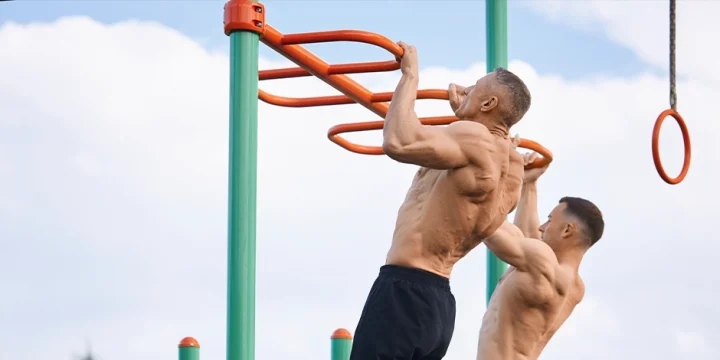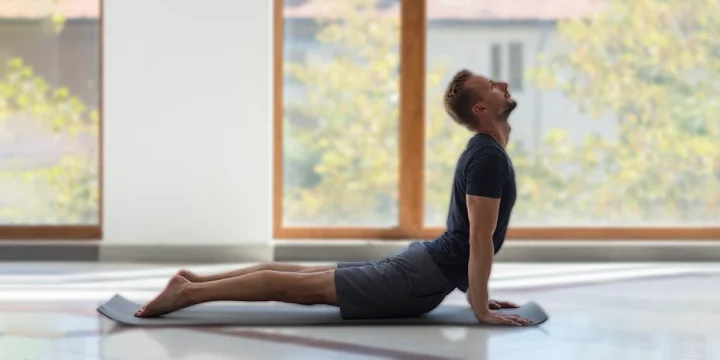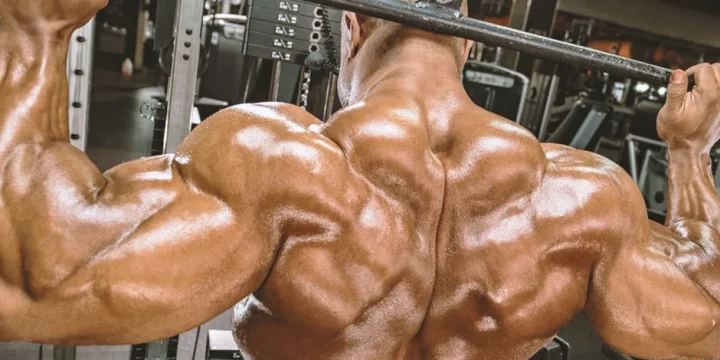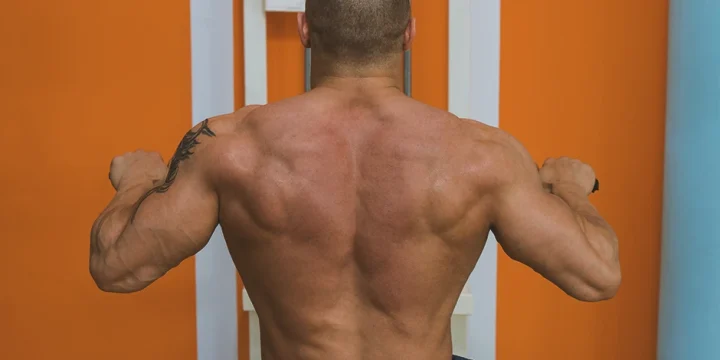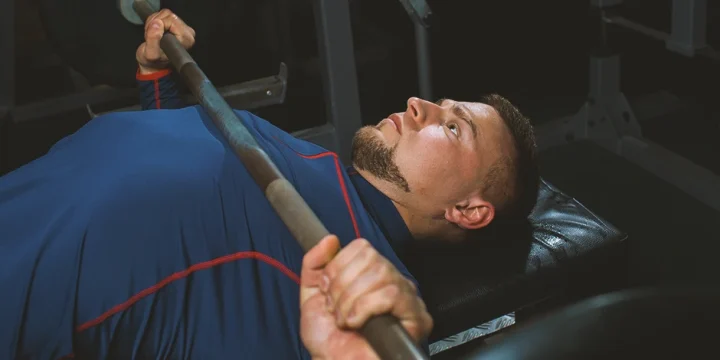Your back muscles are crucial for your posture, spine stability, and overall physical performance.
I’ve reviewed photos of classic bodybuilders and watched a dozen of interviews to examine their training methods.
Here, I will guide you through the best back workouts inspired by some golden-age bodybuilding legends.
I will also provide factors to help you step up your back workout.
Quick Summary
- Classic bodybuilding exercises like seated cable rows, barbell deadlifts, and wide-grip pull-ups are essential for enhancing back muscle strength and physique.
- The effectiveness of seated cable rows in targeting the lats and rhomboids is crucial for building back strength.
- A study in the International Journal of Sports Medicine found that barbell rows activate the core more effectively than machine rows, with 34% higher electromyography activity in erector spinae.
- From my perspective, the integration of a variety of these old-school exercises, with an emphasis on proper form and muscle engagement, is essential for developing a robust and well-defined back.
6 Best Old School Back Workouts

1. Seated Cable Row
In my own training, I've found seated cable rows to be incredibly effective for targeting the lats and rhomboids.
The continuous tension provided by the cables is highly effective in sculpting a strong back and promoting muscle mass, as highlighted in research from The Journal of Physiology [1].
How to do it:
- Put the weight on your preferred setting.
- Sit on the bench of the cable machine with your knees bent and grasp the cable attachment. Keep your arms straight.
- Place your feet on the pads with your knees slightly bent so you can reach to grab the handle.
- Straighten the back and pull the cable toward your torso.
- Pause for three seconds while squeezing your shoulder blades together, then extend your arms to return to your starting position, keeping your back straight.
- Repeat for the desired number of repetitions.
2. Barbell Deadlifts
Deadlifts have been a cornerstone in my back workouts, significantly enhancing the strength and size of my erector spinae. The key is maintaining a neutral spine to maximize gains and minimize risk.
How to do barbell deadlifts:
- Grab a loaded barbell with an overhand grip.
- Stand with your feet a few inches wider than your hips.
- Lift the bar by driving your hips forward.
- Slowly squat down, maintaining a neutral spine throughout this movement.
- Repeat until you reach the desired amount of reps.
"This exercise targets the mid and upper back muscles. It involves bending at the waist and lifting weights using the back muscles. Maintain a neutral spine and avoid rounding the back to prevent strain."
- Sean Ormond, Pain Management Doctor at Atlas Pain Specialists
3. Bent-Over Rows
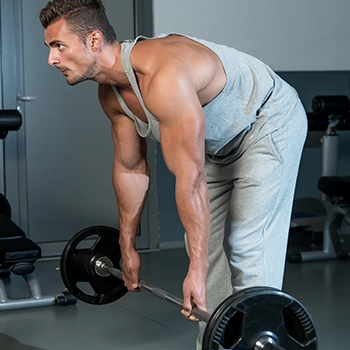
This is another upper-body exercise that can efficiently work your upper back, lats, traps, rhomboids, and posterior deltoids.
A study in the International Journal of Sports Medicine indicates that barbell rows are more effective for core engagement than machine rows, showing a 34% higher electromyography activity in erector spinae for bilateral rows and 12% higher for unilateral free-weight rows [2].
How to do this exercise:
- Stand with a barbell in front, feet shoulder-width apart, and your toes pointed slightly outwards.
- Lean forward by hanging your hips back with your knees slightly bent to grab the barbell with an overhand grip.
- Lift the weight toward your torso, keeping your back straight and at a 45-degree angle to the ground.
- Pause briefly before lowering the barbell to return to the starting position.
- Repeat until you reach the desired amount of reps.
4. Wide Grip Pull-Downs
This exercise primarily works the back’s largest muscle group: the latissimus dorsi, also known as the lats.
They are essential for all pulling workouts and provide support for the spine.
How to do it:
- Adjust the pull-down machine to your preferred weight.
- Adjust the knee pad so it sits on your thighs and minimizes movement.
- Hold the bar with a wider-than-shoulder-width grip and the palms of your hands facing forward.
- Bring the bar down until it reaches your upper chest level.
- Pause for three seconds at the bottom contracted position, and slowly raise the bar to return to the starting position.
- Repeat until you reach the desired amount of reps.
5. Wide Grip Pull-Ups
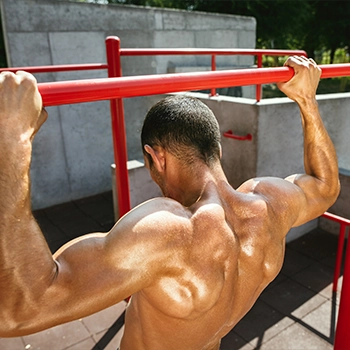
This pull-up bar exercise requires a certain degree of muscle endurance and activates the upper traps, arms, chest, and shoulder muscles.
Some of the biggest names in the bodybuilding industry use this exercise without putting on extra weight, as the goal is to improve blood flow.
How to do it:
- Approach the pull-up bar and grab it with a pronated grip.
- Allow your legs to hang, elevate your chest to engage your lower lats, and keep your chin tucked throughout the movement.
- Pull yourself up using your arms and back. Your elbows should be pointed out to the sides.
- Once your collarbone reaches the pull-up bar, pause for one to three seconds, then slowly lower your body back to return to the starting position.
- Repeat until you reach the desired repetitions, maintaining a straight line from your head to your hips.
“The wide-grip pullup is an effective exercise to strengthen the back and shoulders, since the motion contracts the latissimus dorsi, the largest muscle of the upper body.”
- Allen Conrad, Certified Strength & Conditioning Specialist
6. Dumbbell Rows
The dumbbell row is another effective strength-training exercise for building strong arms and back muscles.
How to do them:
- Stand with your feet shoulder-width apart, engage the core, and bend at the waist until your chest is nearly parallel to the floor.
- Hold a dumbbell in one hand while resting on the opposite knee for support.
- Bring the weight up to your hip, keeping the elbow close to your body.
- Lower it back to the starting position, repeating as desired.
“When starting out, practice with a light weight until your form is satisfactory. A personal trainer or gym trainer can check you for the correct form. Practice in a mirror if necessary. You can add weight as your fitness increases, but it's better to do so modestly so you don't strain your muscles.”
- Paul Rogers, Editor at Verywellfit.com
Nelly Darbois, a physiotherapist and founder of the medical blog Kinedarbois, highly advises maintaining proper form and increasing intensity gradually.
Remember to listen to your body and adjust the exercises as needed.
Regularly incorporating these exercises into your routine can be beneficial for targeting your back.
Related Articles:
What Are Important Factors for Back Muscle Gains?

The most important factors for back muscle gains are:
- Focus on Muscle/Mind Connection - The connection between your mind and body allows you to focus on your muscle group. It ensures that you are performing exercises with proper form. It leads to better muscle activation and injury prevention.
- Time Under Tension (TUT) - Old-school bodybuilders focus on TUT to increase the overall stress their muscles experience during a workout, boosting muscle hypertrophy.
- Incorporating Various Exercises - Single and multi-joint exercises multiple times weekly are critical for continued muscle growth. Switching grips during workouts can help target different muscles from various angles, which prevents plateaus.
- Adding Supersets with Lighter Weights - Old-school male bodybuilders incorporated them into their workouts to increase their metabolism, maintain their muscles, and burn excess fat.
- Including Rest Periods - Adequate rest periods between workouts are crucial for muscle recovery and strength enhancement, a fact supported by a study in the Journal of Strength and Conditioning Research [3]. It is also essential to prioritize sleep for muscle recovery and growth.
- Protein-rich Diet - Proper nutrition is essential for long-term gains in back muscle strength. Eating lean proteins such as chicken, fish, lean beef, or plant proteins will help your body repair after strenuous workouts and build the strong muscles you aim for [4].
- Consume More Calories - To prioritize muscle gains, you must eat enough calories to gain and maintain muscle mass, whether lean meats, whole grains, or healthy fats.
- Add Supplements - The best supplements for muscle gain are protein powders, quality creatine, and top amino acid supplements.
FAQs
What Are the Best Old School Back Exercises?
The best old-school back exercises are barbell deadlifts, wide-grip pull-ups, seated cable rows, bent-over barbell rows, and wide-grip pull-downs.
How Many Times Did Old-School Bodybuilders Train Their Back?
Old-school bodybuilders trained their backs twice weekly as a six-day split routine allowed them to recover and not overtrain their muscles.
References:
- https://www.ncbi.nlm.nih.gov/pmc/articles/PMC3285070/
- https://pubmed.ncbi.nlm.nih.gov/26134664/
- https://pubmed.ncbi.nlm.nih.gov/26605807/
- https://iopscience.iop.org/article/10.1088/1757-899X/335/1/012061/pdf
About The Author
You May Also Like
